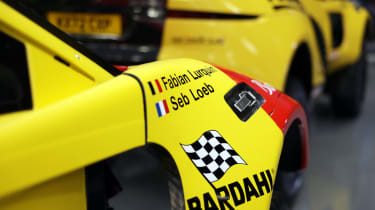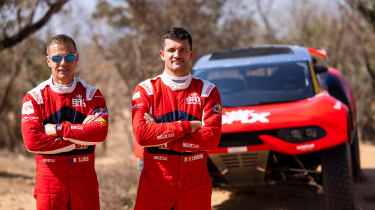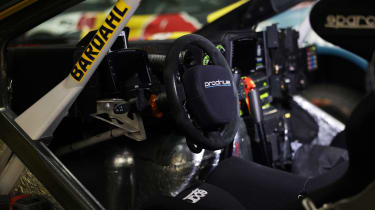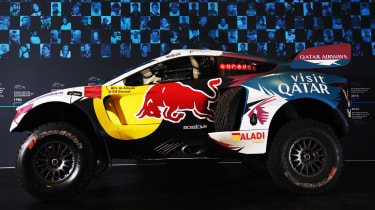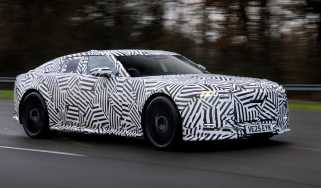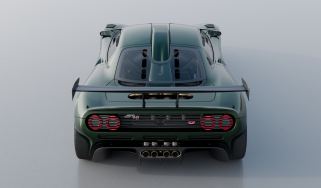2024 Dakar Rally preview: cars, teams, routes and full details
The 2024 Dakar rally roars into life on 5 January. Here’s all the key information, plus an inside look at Prodrive’s Dakar preparations
The 46th running of one of the jewells in motorsport’s crown is about to get underway: the 2024 Dakar Rally kicks off on 5 January.
The Dakar remains one of motorsport’s most fearsome challenges. Here’s everything you need to know about the 2024 event – plus an inside look at British manufacturer Prodrive’s prep for the event.
Where is the 2024 Dakar rally?
The Dakar rally hasn’t raced to Dakar itself since security threats in Mauritania forced the event’s cancellation in 2008. It moved to South America until 2019, and has been held in Saudi Arabia since 2020.
The 2024 route includes a long stint in the Empty Quarter, an enormous sand desert in the Arabian Peninsula, as well as crossing great distances into other parts of the country.
The Dakar is also the opening round of the 2024 FIA World Rally-Raid Championship, with four further events on four different continents culminating in the Rallye du Maroc finale in the Moroccan dunes in October.
How does the Dakar rally work?
The Dakar is a rally-raid event, epic in terms of scale, distance and scenery. There is one stage per day, including one or more special-stage sections, each stage being several hundred kilometres long with waypoints the vehicles must pass through on the route.
Fastest time wins, although competitors are often subject to penalties (for missing waypoints, for example), and gaps between cars often total minutes or even hours, rather than seconds (or tenths of seconds) as in cross-country rallies.
It’s a navigational challenge just as much as it is a driving one, and crews do not know the exact route until they are given a roadbook by the organisers at the start of each stage.
There are classes for cars, bikes, quads, trucks (including the support vehicles for the cars) and classic cars and trucks in the separate Dakar Classic classification too. All together, 425 vehicles will tackle this year’s event.
How long is the Dakar rally?
The rally’s prologue and opening stage will take place on the 5th and 6th January 2024 at AlUla, with the finish and podium celebrations two weeks later on the 19th of January in Yanbu, by the Red Sea.
There are 12 stages, excepting the prologue, and the entire route is around 4900 miles. This year, 60 per cent of the route is brand-new.
How long are the stages of the Dakar rally?
The longest is a new 48-hour ‘Chrono’ marathon stage, where competitors must not only navigate remote territory but work on the cars themselves in the evenings without any outside assistance (although other competitors are allowed to help drivers and co-drivers, their teams won’t accompany them on the marathon stage – they’ll be back at a service camp as much as 500 miles away).
The 48-hour ‘Chrono’ stage route is over a distance of around 370 miles – over terrain that isn’t exactly easy-going.
There is one rest day, immediately after the 48-hour marathon stage.
Who are the key competitors to follow?
In the car class, big names include five-time Dakar winner Nasser Al-Attiyah (who won last year, and the year before that), nine-time WRC champ Sébastien Loeb, Stéphane Peterhansel (who holds the all-time record for Dakar wins, with 14 of them, six of them in the Motorbike class) and rally legend Carlos Sainz Sr. (who has won the Dakar three times).
Legendary British motorsport engineering firm Prodrive is fielding seven of its Prodrive Hunter cars in the 2024 Dakar, its biggest entry yet.
Two of the biggest names are driving Prodrives this year: one Hunter will be driven by Loeb, as part of the Bahrain Raid Xtreme (BRX) team with Red Bull sponsorship, and another by Al-Attiyah, together with his Nasser Racing team.
Two other Hunters are being run by the Brazilian X Rally team and three by the Chinese YunXiang team.
Peterhansel and Sainz are driving for Audi Sport, in the RS Q e-tron – a hybrid-electric rally raid machine powered by an ICE generator.
Sébastien Loeb has driven with Prodrive in rally-raid events for four years, while this will be Al-Attiyah’s first Dakar in a Prodrive Hunter. Loeb has finished second in the last two Dakars, winning seven out of 14 stages at last year’s event.
Loeb’s car has been driven by the Frenchman in multiple rally-raid events since the Mexican Sonora Rally in spring 2023; some of the other Hunters being prepared in Prodrive’s spotless Banbury facility are brand-new, box-fresh. They’ll never be this clean again.
By the time you read this, the cars will already be in Saudi Arabia, having been shipped in December, directly from scrutineering in Barcelona. evo visited shortly before the cars were transported to Spain in November, where Prodrive HQ was a hive of activity making its final preparations.
How big is the headcount for teams on the Dakar rally?
Prodrive is taking 62 people to look after the seven Prodrive Hunter cars entered into the rally by the different teams. Forty-four of them will be assigned to Loeb’s BRX car and Al-Attiyah’s Nasser Racing car.
At Prodrive’s HQ, we saw spares trucks being prepared with stations ready for rapid diff and gearbox rebuilds – and an equally important, military-style ‘brew kit’ for tea.
Two of Prodrive’s support vehicles are T5 race trucks, which will be entered into the rally and classified in the results. They follow around one to two hours behind the cars – no small achievement in terms of pace. They’ll play a crucial role on the marathon Chrono stage too, where although only the drivers and co-drivers entered in the rally being allowed to work on the cars, the trucks will be able to carry a spare gearbox to take to the crew to fit, if it were needed, for example.
Prodrive must take six trucks to the Dakar all together, one a 6x6 wheeler, the others 6x4. All being well, the spares and engineering support trucks will have as quiet a time as possible; if not, they’ll be playing a crucial role. ‘It’s a big investment for something you hope you don’t use,’ is how one team insider puts it.
Add to that three vans (with serious off-road tyres and suspension), and multiple motorhomes for accommodation and operations offices. The 62-strong crew will sleep in a mixture of tents and vehicles.
The trucks and support vehicles have headed to Barcelona to be scrutineered before being shipped to Saudi at the start of December.
Last year saw extreme rain to go with spells of extreme heat. ‘Up until two weeks ago we were still finding boxes with water in,’ one team member recounts. ‘Everything to do with the Dakar is a challenge.’
> Prodrive P25 review – this £552,000 Subaru Impreza is worth every penny
Prodrive Hunter: engine, performance and specs
The Hunter is powered by a 3.5-litre twin-turbo V6, fuelled by Coryton e-fuel (part biofuel and part carbon-capture e-fuel). It develops around 400bhp and 440lb ft of torque with the ‘Equivalence of Technology’ that all teams have to abide by.
More serious than the performance figures are the numbers relating to the car’s sheer scale: compared with the compact race and rally cars Prodrive might ordinarily be associated with, the Dakar challenger is an enormous machine. It’s 2.3 metres wide (an increase over previous years, made possible by a change in the regulations), with a kerb weight somewhere around the regulated two-tonne limit.
Stand next to the Hunter and it towers over a tall person; stepping up into its cockpit is a climb requiring a firm handhold and foothold. evo is allowed to clamber into Sébastien Loeb’s car (which is no little thrill in itself, holding a steering wheel worn smooth by being wrestled over thousands of miles of rally-raid stages by the living legend. Despite the car being cleaned countless times, there’s a fine haze of rally-raid dust over every surface).
Considering it’s such an enormous car on the outside, it needs to be cramped inside. The engine is positioned as far behind the front wheels as possible for weight distribution and axle articulation, and the south end of its block is virtually sharing the cockpit with Loeb and his navigator Fabian Lurquin, the bulkhead bulging back through the dashboard between the seats. If you were to view the car in cross-section, the driver’s pedals are actually partway in front of the engine’s outline.
That makes heat management a challenge, and air-con is an essential to prevent the worst symptoms of heat exhaustion.
The windscreen is very big, one of the biggest in the Dakar in fact, because the Hunter’s droop-snoot design enables the driver to see the front of the car more easily to plot a route when climbing dunes at a steep angle.
There are screens for the co-driver in the form of tablets for navigation, with a back-up in case of a failure. Navigation is crucial, with the driver following a heading to the next waypoint. If they miss it, they may need to turn back; a disaster for lost time, and potentially dangerous too.
Top speed is limited by regulations to 170kph (106mph); more than fast enough for the terrain the Dakar stages involves, and speeding in public road link sections is subject to penalties. The rear wing’s job is partly to keep the back down when the car takes off over jumps, to avoid an end-over-end smash.
The sheer length of the stages requires a near 500-litre fuel tank; ten times the size of a Volkswagen Golf’s. At a stage’s startline, the full tank can add as much as 400kg to the Hunter’s weight.
Suspension travel is vast, with two springs at each corner. Ram-air cooling vents help direct airflow to help cool the shock absorbers on the stages. Picking up one of the enormous wheel-and-tyre assemblies is a lift-with-your-knees, stretch-first job. The 17-inch rims are dwarfed by the 37-inch tyres enveloping them.
Spare wheels are stashed in an easily accessible position, together with tools, a tow rope and spare driveshafts (which are all the same length, and common with the propshaft). Given that drivers and co-drivers must work on the cars alone on the marathon stage, accessibility and ease of maintenance could make the difference between victory and defeat.
You can follow the 2024 Dakar rally on the Dakar mobile app, and on Red Bull TV.


